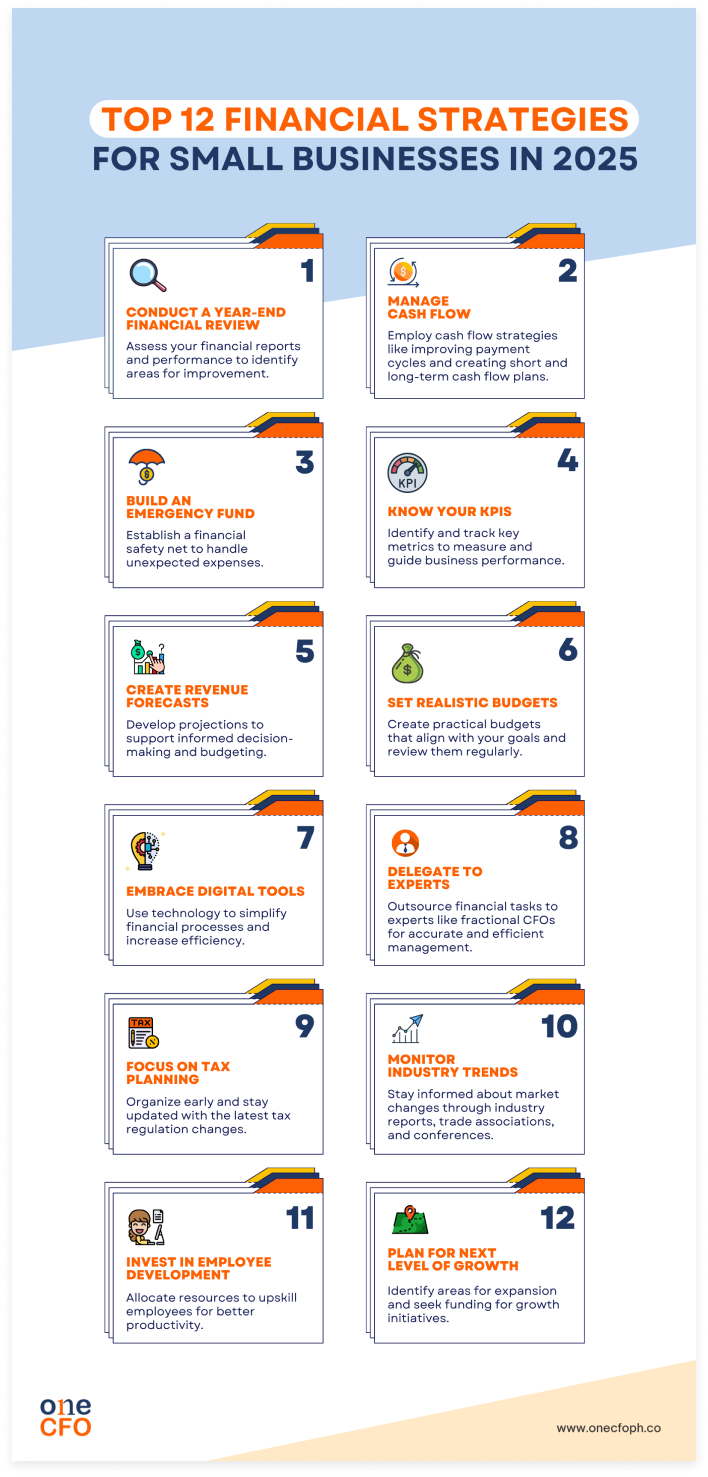
January 15, 2025 | 10:46 pm
Table of Contents
Small business success hinges on adopting innovative financial strategies to thrive in 2025.
Embracing these strategies will be crucial in navigating the evolving economic landscape and
overcoming the challenges ahead.
Whether you’re a seasoned entrepreneur or just starting, having actionable financial
strategies will equip you with the knowledge and tools to make informed financial decisions,
minimize risks, and achieve business goals.
Furthermore, small businesses can outmaneuver the competition, increase profitability, and
achieve financial success with the 12 financial strategies outlined in this article.
Let's dive in and discover how to make 2025 your most successful year yet!
What are the top financial strategies for small businesses in 2025?
To stay competitive and resilient in a fast-changing economy, small businesses should implement robust financial strategies this 2025. These financial strategies position small businesses to thrive in the challenges and opportunities that lie ahead.

Conduct a year-end financial review
It is crucial to review your past financial performance to be able to get a good
understanding of your current financial situation. Evaluating where your business has been
provides valuable insights to help create a more effective plan for thriving in 2025.
Assess last year’s financial reports, such as income
statements, balance sheets, and cash
flow statements, to pinpoint your wins and areas for improvement in the coming year.
If you’ve fallen behind or lack the time to prepare these reports, consider outsourcing to
financial experts who can help you catch up on accounting tasks and financial statements
preparation.
In addition to financial reports, review the previous year’s expenses and how the company
performed against the initial budget.
Analyzing your financial performance will help you develop actionable plans and determine
which strategies work.
Manage your cash flow
Cash flow issues are among the most common reasons small businesses fail. Proper cash flow management ensures you can sustain
your daily operations, fund your growth, and thrive in
2025.
A straightforward way of improving your cash flow is managing your payment cycles. In
business, it’s advantageous to reduce the time it takes to collect payments, which means
invoicing and receiving funds as quickly as possible. At the same time, extend your payables
by negotiating extended terms with your suppliers.
Another cash flow strategy is creating a 13-week cash flow model to plot all your
upcoming
expenses and revenues week by week. This plan will help you monitor your cash flow closely
and adjust your spending if needed.
This short-term cash flow forecasting method provides crucial visibility into a business's
financial health. For example, a manufacturing company can use a 13-week forecast to
anticipate expenses like raw materials, labor, and utilities. This foresight empowers
proactive decision-making, enabling businesses to navigate potential cash shortages or
surpluses effectively.
In addition, SMEs may also implement a comprehensive cash flow forecasting approach. Combine
short-term (e.g., 13 weeks) forecasts with longer-term plans (e.g., 1-year) to create a
rolling budget. This dynamic approach allows you to prepare for various scenarios, from
best-case to worst-case, and navigate uncertain times effectively.
Discover valuable strategies for effective cash flow management by watching this engaging
video!
Build an emergency fund
Even if you have the most well-planned operations, unforeseen circumstances like another
pandemic, economic downturns, or other emergencies can still happen.
If you haven’t yet, make it a goal to build an emergency or contingency fund, typically
three to six months’ worth of operating expenses.
Emergency funds serve as your
business’s safety net, so you won’t have to make big cuts or
incur debt when unexpected costs arise.
When saving up for an emergency, keeping it in a high-yield savings account is best to earn
interest while keeping it accessible. Also, make sure to replenish it after you’ve made any
withdrawals.
Know your KPIs

Another financial strategy for financial success in 2025 is tracking your key performance indicators or KPIs.
There are many KPIs for sales, marketing, and finance, but you don’t have to track them all
at once; you can choose only those that align with your business goals.
For example, you can track gross margins to determine your
profitability. You can also
monitor metrics like cash conversion cycle and operating cash flow to improve cash flow.
Regularly monitoring and analyzing KPIs allow business owners to make data-driven decisions,
track progress, and boost financial performance.
Create revenue forecasts
Creating revenue forecasts is another way to help you easily
plan for the future and budget.
By analyzing historical sales data, market trends, and economic conditions, you can build
revenue projections for the new year.
Since building projections requires technical and financial expertise, consider outsourcing
to fractional CFOs who can provide precise revenue forecasts to support informed
decision-making.
You may also request your projections to be broken down by product lines, services, or
customer segments for a more detailed forecast.
Furthermore, regularly update your forecasts with the most accurate data to reflect actual
market or operational conditions.
Set realistic budgets
Setting a comprehensive and realistic budget is a must every year. Your business budget
serves as your blueprint for spending so you can efficiently allocate every peso.
When setting a budget, incorporate your insights and
findings from financial reviews and
forecasts.
Another tip in organizing a budget is to categorize expenses into operational costs, growth
initiatives, and contingencies to ensure you have everything covered.
You can also group expenses into essentials and discretionary costs to quickly know which to
postpone or adjust during a cash crunch.
Lastly, regularly monitor your budget and identify any deviations between actual income and
spending and budgeted figures. Knowing these deviations and adjusting accordingly will
ensure your budget remains a valuable tool for decision-making.
Embrace digital tools
Technology can quickly revolutionize how businesses manage financial processes in this
digital age. If you’re not taking advantage of digital tools and systems yet, 2025 is the
year to do it!
Accounting software like Xero helps businesses automate invoicing, expense
tracking, and
financial reporting.
However, if you need something more comprehensive that covers every business area, you can
use enterprise resource planning software or ERP as an all-in-one software. ERPs
like Britana not only cover accounting functions but also
areas like inventory and sales
order management.
With digital tools, SMEs can save time, minimize errors, and access real-time analytics for
their decision-making.
Delegate to experts
Small business owners often wear many hats, sometimes even managing sales, marketing,
customer service, and operations simultaneously. While some manage their finances, effective
financial management requires specialized expertise.
To avoid losing focus, outsource accounting and CFO services for tasks like
bookkeeping, tax
preparation, financial reporting, and strategic planning.
Doing so helps you save time, ensure compliance, and focus on what you do best for your
small business. Outsourcing to experts also gives business owners peace of mind, knowing
their finances are handled well.
Focus on tax planning
As SMEs prepare for the 2025 tax year, focusing on tax planning should be a top priority. By
thinking ahead about tax, businesses can take a proactive approach to understanding the
implications of new tax regulations and identifying opportunities for minimizing tax
liabilities.
In this regard, SMEs can enjoy tax deductions, significantly reducing their taxable income
and lowering their overall tax liability.
Tax deductions can arise from
various expenses, including operational costs, employee wages,
and investment in equipment or technology. By carefully tracking and documenting these
expenses, businesses can maximize their deductions and reinvest the savings into growth
initiatives, employee development, or improving services.
Also, proper tax planning ensures compliance with ever-changing tax regulations, such as
using invoices instead of official
receipts and imposing withholding tax on online sellers.
Understanding the intricacies of tax regulations can help businesses identify opportunities
for further tax benefits, ultimately supporting better financial health in the long run.
Watch this video to discover legal ways to minimize your tax liabilities:
Monitor industry trends
If you’re wondering how SMEs can better navigate change, the quick answer is monitoring
industry trends.
Staying informed about shifts in the industry and the market can help you become more
competitive and thrive in 2025.
Some reliable sources you can go for are industry reports, government publications, and
trade associations. You can also join conferences to learn the latest news or network with
other business owners.
However, the work doesn’t stop at monitoring. Once you identify these market shifts, you
must take action and adapt your business model. An example is investing in digital systems
once you notice a digitalization trend among your competitors.
Invest in employee development
Being financially successful in a business doesn’t only stem from excellent sales or
efficient operations - a skilled and motivated workforce also plays a significant role.
Allocate a specific budget for training programs, workshops, and certifications to encourage
your employees to upskill. Keep open communication within the company to understand what
your employees need to grow professionally.
As a business owner, you should also review if your staff's current skills align with the
company's strategic goals. This way, you can tailor training programs or hiring strategies
to address the skill gap.
Knowing how to address employee needs will boost productivity in the workplace, reduce
turnover, and inspire them to innovate.
Plan for the next level of growth
If your business has been stagnant for a while, it might be because you haven’t planned the
next level for your company. As they say, growth doesn’t just happen by chance – you must
make it happen through strategic planning.
To start, pinpoint the areas you can explore for expansion, such as tapping into new
markets, launching new products or services, or upgrading your infrastructure.
However, not all small businesses can easily afford growth initiatives. When this happens,
you can choose from several funding options like bank loans, grants, or venture capital
funding.
How can small businesses thrive in 2025?
The key to not only surviving but also thriving in 2025 is preparing and strategizing
early.
Establish a strong financial foundation by applying this article's 12 effective financial
strategies.
Additionally, consider collaborating with financial experts like OneCFO, the preferred
fractional CFO among various SMEs, startups, and scaleups in the Philippines, to enhance
your financial management further and drive your business forward.
OneCFO is your
partner for growth, providing world-class fractional CFO services to small
businesses. From bookkeeping, tax planning, financial reporting, financial projections, and
more, OneCFO has your back!
Visit us at onecfoph.co or email us at [email protected] to
discover how our fractional CFO
expertise can help small businesses thrive in 2025 and beyond.
Read our disclaimer here.